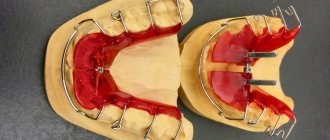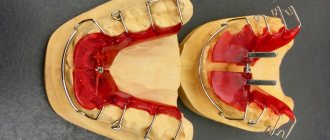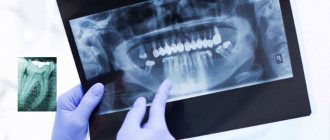Causes of delayed teeth emergence
A lot depends on nutrition: breastfed babies depend on the quality of breast milk. Babies who grow up on artificial formulas receive slightly more vitamins and minerals, because the formulas contain a clearly calculated amount of nutrients.
- If a child does not have a single tooth at 1 year of age, this may be a consequence of some previous disease: intestinal dysfunction, impaired metabolism, as well as insufficient calcium and vitamin D.
- Teeth may be delayed due to the special course of pregnancy; perhaps the mother suffered complications during the gestation period./li>
- Eruption after 12 months may mean that the tooth is not positioned correctly in the gum, for example, it is growing horizontally.
- Congenital absence of tooth buds in a baby. These are either hereditary disorders or a congenital pathology caused by a disruption in the normal course of pregnancy. It happens very rarely.
How can parents understand that at 12 months the baby’s teeth are simply delayed and they need to be patient, and when should they sound the alarm?
Pediatric dentists allow the first teeth to be delayed for 6 months, so if after the baby’s 1st birthday not a single baby tooth has grown, you should wait a little longer. Try to find out from your relatives about the timing and characteristics of the appearance of the first milk teeth in their childhood, perhaps this is just a family trait.
But if the teeth are already delayed by more than 6 months, and the baby’s gums do not even think of swelling, then you should contact a pediatric dentist. The specialist will conduct an examination and advise what needs to be done to help teeth appear faster.
In addition to the above reasons, the appearance of teeth after 12 months may be affected by the following:
- The teeth are located very tightly in the gums.
- There are diseases of the endocrine system, for example, hypothyroidism, due to which the activity of the endocrine glands is reduced.
- The baby suffered serious systemic diseases.
In this case, the pediatric dentist will recommend a biochemical blood test; the baby will need to have the thyroid gland examined, including an ultrasound examination. After the results are obtained, the dentist will be able to prescribe the necessary course of treatment.
Make an appointment
How can you help your baby?
The main question, what to do if a child has no teeth at 8 months, requires an immediate solution. Therefore, the recommendations in such a situation are clear:
- never cause mechanical damage to the gums yourself;
- Chewing can be stimulated using a special device;
- review the baby’s nutritional issues by discussing them with the pediatrician;
- up to 11-12 months you can monitor the situation - nothing bad happens in the child’s body;
- If there are still no teeth, then you need to see a dentist.
What can a doctor do? Despite the child’s infancy, the doctor will prescribe an x-ray of the jaws. This will help diagnose edentia. In any case, you should always strictly follow the recommendations of the pediatric dentist, who will always try to help the baby.
How to help your baby?
Initially, the dentist will take an X-ray of the baby's jaw to make sure that the baby has the rudiments of teeth inside. If there is, then eruption will happen soon. At first, the gums will swell a little and salivation will become very abundant: these are the main symptoms of the rapid appearance of teeth. You can help them a little:
- Teether toys are an excellent device for training gums; they help relieve severe itching and reduce pain.
- Mothers should learn how to gently massage their baby’s gums. It is better to massage with a clean finger lubricated with a special gel for children's gums.
- It is important to add healthy purees and healthy foods to your baby’s diet that will help the child’s body receive the necessary microelements and vitamins.
If the baby generally develops within normal limits, eats well, sleeps, is active and cheerful, then the absence of teeth at 1 year is definitely not a reason to panic. Each child develops at his own pace. In general, boys tend to lag slightly behind girls in some physiological parameters.
From this article it follows that you should not worry unnecessarily! If in any doubt, seek advice from a pediatric dentist at our Babydent
Show more tips
Over 1 year old
At one year of age, children, as a rule, already have eight full milk teeth in their mouths. This age limit is the optimal time to visit the dentist. The doctor will evaluate the condition of the oral cavity and help prevent problems.
At the age of 1.5-2 years, a child can have from 4 to 14 teeth. We must begin to accustom him to oral hygiene, showing him how cleaning is done by example. By the age of 2.5 years, children, as a rule, acquire two dozen milk teeth, which serve them until the age of 5-6 years. A visit to the dentist or orthodontist may be necessary if:
- premature development of the jaws, which is facilitated by endocrine dysfunction;
- growth retardation, often caused by rickets, digestive problems, infections and genetic inheritance;
- incorrect position of the incisors, indicating deeper bone disorders.
Until the age of six, the number of teeth remains the same - about 20. At this time, you need to continue to develop in the child a love of oral hygiene, wean him from finger sucking and nail biting.
The first replacement of baby teeth with molars begins at 6-8 years of age. By the age of 14-15, the jaws are completely renewed.
Individual characteristics
The average time for the appearance of the first baby tooth is 6 months, but teeth can begin to erupt at three months or a year, and both options are normal. If the child’s teeth do not appear, but there are no other complaints and the pediatrician does not notice any problems, then there is no need to worry until the child is a year or more old.
The same applies to the late beginning of the change of milk teeth to permanent ones. For some children, permanent incisors begin to appear already in the senior group of kindergarten, while others experience this moment at school. The normal period for the formation of a permanent bite is from 7 to 13 years.
Later than the average period, teeth may erupt in weakened, often ill children.
What to do?
Monitor other complaints, contact doctors if necessary, and if there are no complaints, then nothing. You cannot influence the rate at which teeth appear.
Completely edentulous
This is a rare phenomenon - the complete absence of tooth buds (deciduous or permanent). In this case, teeth cannot erupt because they are simply not in the jaw bone.
Complete edentia in the picture
In medicine, cases have been described when a patient had milk teeth, but permanent teeth were completely absent. The loss of baby teeth was timely, but permanent teeth did not appear in return. At this moment, the child’s parents paid attention to the problem, and the dentist made a diagnosis.
In addition to congenital, adentia can be acquired if the child has undergone severe treatment (chemotherapy) at an early age. Due to the toxic effects of drugs, tooth buds may be damaged.
What to do?
Edentia is clearly visible on a CT image. If such a diagnosis is made, the only option is complete prosthetics. Since the case is rare, the question of when to get dentures and in what way should be decided individually.
If you do not replace missing teeth with prosthetics, the chewing process cannot be complete. Even the lack of 2-3 teeth affects digestion. Bone tissue, if the jaws do not receive enough load when chewing, undergoes resorption (resorption), and this leads to weakening and loosening of the remaining teeth, increasing the risk of periodontal disease.
Therefore, if you have any complaints about your child’s teething being too slow, you should consult a doctor. In most cases, it turns out that there is no pathology, all teeth are fine and will grow a little later. But in rare cases, prosthetics may be required, which is better to know in advance. Then you can schedule treatment on time.
Other articles:
If a child does not want to be treated by an orthodontist...
When should your child see an orthodontist?
How to help your child not be afraid of dentists
What are normal teething symptoms?
It should be understood that teething is an ordinary physiological process that in itself does not cause serious health problems. However, children during this period may experience anxiety, be capricious, and exhibit a number of alarming symptoms. First of all, in the place where the tooth erupts, swelling and increased sensitivity of the gums are observed. The child begins to actively suck, chew and bite surrounding objects. He has increased salivation, which can irritate the skin around his mouth. These are the main symptoms that are observed in almost all babies. Fever, hyperexcitability, loss of appetite and sleep disturbances are common, but they do not appear with every new tooth. Suffice it to remember that the complete dentition is usually formed by the age of three, and children usually experience severe anxiety only in the first year of life.
For reasons unrelated to teething, the following symptoms may appear:
- increased body temperature;
- frequent bowel movements;
- nausea, vomiting;
- nasal congestion.
First of all, it is necessary to take into account the individual characteristics of the child. The symptoms inherent in a particular constitution can be summarized in a table [3].
| Allergic type (normal excitability of the central nervous system, tendency to allergic manifestations) | Lymphatic-hypoplastic type (reduced excitability of the central nervous system) | Neuro-arthritic type (increased excitability of the central nervous system) |
| Teeth are cut on time and in the correct order. Possible rash, respiratory infections, loss of appetite, and frequent bowel movements. Body temperature is normal. | Teeth cut late and in the wrong order. There is profuse drooling, runny nose, swelling and soreness of the gums, and frequent bowel movements. Body temperature is normal. | Teeth are cut on time and in the correct order. Teething causes pain, excitability, sleep and appetite disturbances, and vomiting is possible. Body temperature rises. |
Vomiting and high fever during teething, caused by the constitution, are characteristic only of the neuro-arthritic type. Only 13.1% of children fall into this category. The main types are lymphatic-plastic, its share is 53.5%, and allergic - 33.4% [3]. Thus, if a child belonging to these two types begins to vomit during teething, it is most likely due to an associated respiratory infection. However, children of the neuro-arthritic type are not protected from infection. The period of teething coincides with the introduction of complementary foods, the baby receives fewer antibodies from mother's milk, and immunity decreases. Therefore, in any case, if the body temperature rises above 38°, vomiting, or thick greenish discharge from the nose, you should call a doctor so as not to miss the onset of pneumonia, pyelonephritis or meningitis.
Teething syndrome is included in the International Classification of Diseases, but is a diagnosis of exclusion. Its signs:
- liquid transparent nasal discharge caused by excess mucus production against the background of gum inflammation (no more than 5 days);
- loose stools up to 5 times a day as a result of salivation, which increases intestinal motility;
- short-term increase in temperature, no more than 38°;
- vomiting, if infection is excluded and the child belongs to the neuro-arthritic type.
Teething order
Diagram of the eruption of baby teeth (numbered in order of priority)
Finding out the sequence of teeth appearance in children will be useful for young parents who have already felt the joy of becoming a mother and father, or this is still to come in the future. By the end of the first year, children have several teeth. The number is determined by a number of factors. One reason is heredity.
Problems in the baby’s body that arise as a result of:
- low calcium content in the body and the formation of rickets.
- dysfunction of the thyroid gland and, as a result, a decrease in hormones in the blood.
- absence of incisors (edentia).
- dysfunction of the gastrointestinal tract.
Baby teeth
While still in the womb, the rudiments of dental formations are formed in the fetus. And by the middle of pregnancy, the required number and order of appearance of one or another incisor is formed.
It must be taken into account that a child’s oral bone formations should number 20. The time of eruption of baby teeth and the order are of a purely individual nature. However, there are generally accepted norms, which are an indicator of the correct physiological development of the baby. So how do children usually grow their teeth? Let's take a closer look at this topic.
First tooth
In babies, the first pair of teeth appears on the lower jaw. Which tooth of a given pair should appear first? Pediatricians say that teeth can erupt at the same time or with an interval of several days. And you shouldn’t worry about which incisor appeared first, because there are no special rules for this. Usually, young parents are happy to see their child’s first tooth appear at 6-7 months of his life. But at the same time, the scope of the norm expands significantly - from 4 to 9 months.
Second pair
Following the growth of the lower incisors, the upper ones should appear. The order in which the right or left incisor appears first does not matter. The interval between their occurrence can vary from several hours to two weeks.
According to statistics, the upper incisor appears first on the side from which the lower one appeared. The upper teeth normally erupt at 5-11 months. Usually at eight months.
Third pair
How does a child’s teeth continue to grow? After the child begins to smile with his 4 teeth, his lateral incisors, which are located on the upper jaw, appear. The third pair of bone formations appears at 10 months. Medical experts consider it normal for these teeth to erupt from 7 months to a year.
Fourth pair
The lower lateral incisors appear between 9 and 15 months.
The child's next teeth are the upper and lower molars. Normally, they appear before the fangs. But in recent years, doctors have increasingly encountered exceptions when the canines form first. And after 2-3 months, the lower molars are also replenished in the mouth.
Molars begin to grow at the age of 1-1.5 years. Let us immediately note that molars are large formations and their eruption is accompanied by high fever, lack of appetite and capriciousness of the child.
The next stage of the teething scheme is given to the canines. Fangs usually appear between the ages of one and a half to two years. But there are cases when they are formed earlier than paired molars.
Fangs, like painters, make themselves felt through the manifestation of the following symptoms: pain and itching of the gums, symptoms of rhinitis, changes in stool. These signs disappear as soon as a new tooth appears.
The second group of upper and lower molars erupt painlessly and asymptomatically at 2-3 years. This group is the final one in the chain of primary (non-permanent) teeth. After the milky bone formations of the oral cavity begin to fall out, permanent teeth will grow.
Generally accepted teething pattern
Children at 2.5 years old should have 4 incisors and 4 molars, as well as 2 canines. This scheme looks like this: 2-1-2 (2 incisors, 1 canine, 2 molars grow from above and below from each half of the jaw).
In order to determine the normality of a child’s teeth, a special formula is provided. The calculation is carried out as follows: the number of teeth should correspond to the difference in the age of the baby in months and six. For example, at 1.5 years (17 months) this number is 11 (17-6=11). The method for determining the required number of teeth is more appropriate to use for children under two years of age, then the formula will be more accurate.
First teeth: symptoms of their eruption
The progress of teething is usually accompanied by certain symptoms. These signs are reflected in behavior and emotional state. The following manifestations are considered normal:
- secretion of saliva in large quantities. This symptom usually appears at the end of 2 months and can last up to 4.
- looseness and hyperemia of the gums – lasts for quite a long time.
- skin irritation in the lips and chin area. The appearance of an allergic reaction is caused by excessive salivation. To prevent irritation on the baby's delicate skin, parents should wipe his mouth more often and lubricate the skin with baby cream. For better absorption of the cream, it is better to apply it at night.
- The gums turn red and begin to itch. This manifests itself when the baby is breastfeeding, because he bites the nipple.
- the presence of pain disrupts the baby's sleep. For some time he will not be able to fall asleep on time, and the duration of sleep will be shorter. During this period, some pediatricians recommend giving the baby analgesics.
- Lack of appetite and refusal to eat are common problems during the teething stage. This symptom is caused by pain when eating food. The exception is the mother's breast.
- thumb sucking or the desire to chew on something. Most often, the child puts into his mouth any object that catches his eye and begins to gnaw on it. Therefore, it is necessary to ensure that toys and other items are clean.
- hematomas or bruises - medium-sized bulges on the gums with a bluish tint. There is no need to worry about their occurrence if their number is insignificant. You can apply cold compresses to the bumps. The hematomas will gradually disappear on their own.
All of the above signs have virtually no effect on the baby’s behavior and well-being, and disappear after teeth appear.
How to help a child with incisor teeth?
As soon as the baby begins to be bothered by the symptoms associated with the manifestation of incisors, parents begin to look for ways to eliminate negative phenomena. There are many tips and recommendations from specialists that can help you survive this stage of a child’s development more easily and without any consequences.
How can I make teething easier for my baby?
- You should provide your child with objects that he can chew on. This will relieve his anxiety and massage his gums.
- For this purpose, rubber toys filled with liquid or gel filler are best suited. They are designed to achieve a cooling effect on the gums. The main disadvantage of such items is that they will have to be periodically placed in the refrigerator.
- Pacifiers or bottles. The chewing or sucking mechanism helps soothe irritated gums. It should be taken into account that regular sucking and chewing of objects with an irregular shape can cause the formation of an abnormal bite. That is why it is necessary to purchase a pacifier with a special shape and made of high-quality material.
- A finger brush is a remedy for eliminating itchy gums in a baby. Recently, it has become increasingly popular and in demand among young mothers, because in addition to its main action, the brush is an assistant in caring for the oral cavity of babies.
- At home, in the absence of special care items, it is possible to use gauze swabs, which are pre-moistened in cold water. This method simultaneously eliminates itching and cleanses the oral cavity of microorganisms. Massaging the gums with a gauze swab should be done carefully, gently, without sudden movements that can injure the oral mucosa.
- Most methods are ineffective. In extreme cases, resort to medication. Pharmaceutical companies offer a huge number of special gels and ointments for topical use. It is better to select the appropriate remedy together with your pediatrician.










